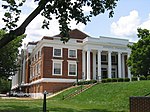Brown College at Monroe Hill

Brown College at Monroe Hill is one of three residential colleges at the University of Virginia. Originally named Monroe Hill College, Brown opened in 1986 as the first modern residential college at the University of Virginia. It was renamed Brown College at Monroe Hill in recognition of the endowment donated by the Brown family (of the Brown-Forman Corporation) in 1994. The college is led by James Coan, Principal, and John T. Casteen IV, Director of Studies. A number faculty fellows from many departments and schools of the university maintain close ties to the college. The compound that conforms the college is principally made of the following buildings known as portals: Davis, Smith, Mallet, Long, Venable, Gildersleeve, McGuffey, Harrison, Tucker, Holmes, Rogers and Peters. Each portal houses approximately 24 students and all twelve are connected by underground passages frequently referred to as tunnels.
Excerpt from the Wikipedia article Brown College at Monroe Hill (License: CC BY-SA 3.0, Authors, Images).Brown College at Monroe Hill
Newcomb Road South,
Geographical coordinates (GPS) Address Nearby Places Show on map
Geographical coordinates (GPS)
| Latitude | Longitude |
|---|---|
| N 38.034833333333 ° | E -78.507722222222 ° |
Address
Harrison Portal
Newcomb Road South
22903
Virginia, United States
Open on Google Maps







